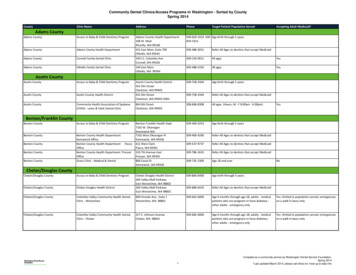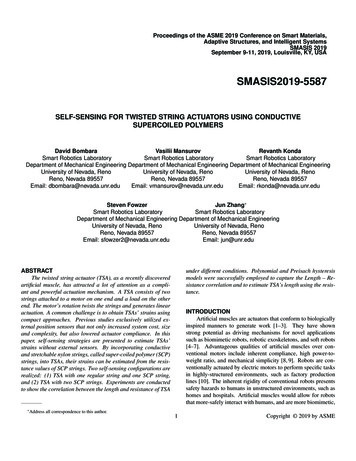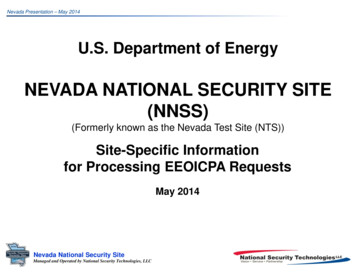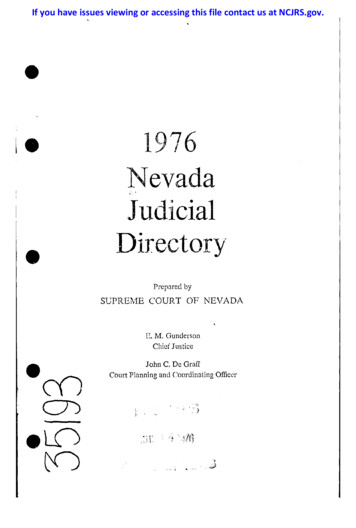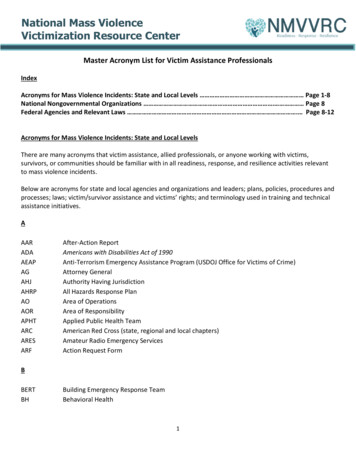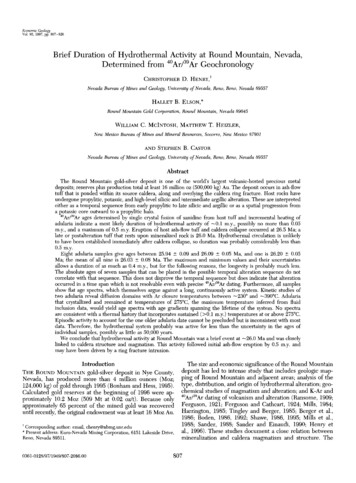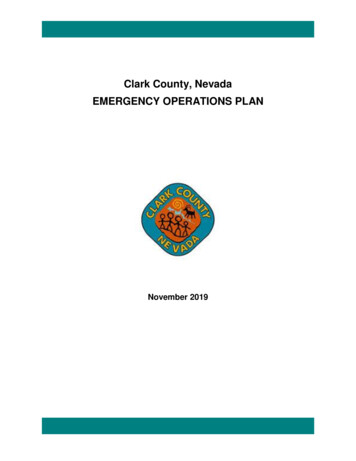
Transcription
Clark County, NevadaEMERGENCY OPERATIONS PLANNovember 2019
THIS PAGE LEFT BLANK INTENTIONALLYii
Clark County EOPBasic PlanImmediate Action ChecklistImmediate Action ChecklistUse the following Immediate Action Checklist to initiate Clark County’s response to and support of anemergency incident.1. Receive alert of incident. Alerts may be received through 9-1-1 dispatch, responding agencies, on-sceneIncident Commander, or the public.(See ESF 2 – Telecommunications for more information)Alert the Emergency Manager.If the Emergency Manager is unavailable, alert alternates based on line of succession. (See Section 1.8.1).2. Determine need to implement the Emergency Operations Plan (EOP).Determined by Emergency Manager, in coordination with the on-scene Incident Commander, what level ofsupport is needed from the County for the incident. This may range from the Emergency Manager being onstand-by to full activation of the Clark County Multi-Agency Coordination Center (MACC).Utilize Incident Command System in managing the MACC.Primary MACC LocationAlternate MACC LocationsClark County Fire Department, 575 E. Flamingo Rd., Las Vegas, NVAlternate 1: Clark County Government Center, 500 S. Grand Central PkwyLas Vegas NV 89106Alternate 2: McCarran International Airport, Department of AviationAdministrative Bldg., 1845 E. Russell Rd., Las VegasImplement County Continuity of Operations (COOP) procedures, as appropriate.Identify the key personnel needed to support emergency operations, including staffing the MACC, ifactivated.3. Notify key personnel and response partners. (See Emergency Contact List maintained by EmergencyManager.)Based on incident needs, the Emergency Manager will notify Clark County Emergency Management and theNevada Division of Emergency Management (NDEM) of the MACC activation.Notify appropriate emergency response agencies using the calling tree or calling roster. Initial notificationrequests will be made by the Incident Commander through County Dispatch as the primary 9-1-1 entry point,and requests for support will be forwarded to the Emergency Manager to determine the incident’sjurisdiction. Contact the NDEM Duty Officer or the State Emergency Operations Center (SEOC) at 775-687-0400 If there is an oil or chemical spill to report, responsible parties should call the National ResponseCenter at 800-424-8802, the Nevada Division of Environmental Protection at 888-331-6337, theNevada State Emergency Response Commission at 775-684-7511, and the local fire department ifthey have not been contacted already. If radioactive materials are involved, call 877-438-7231.iii
Clark County EOPBasic PlanImmediate Action Checklist4. Establish communications with the on-scene Incident Commander. (See ESF 2 – Telecommunicationsfor more information on communications systems.)Identify primary and back-up means to maintain contact with the on-scene Incident Commander.5. Identify key incident needs, in coordination with the on-scene Incident Commander.Consider coordination of the following, as required by the incident: Protective action measures, including evacuation and shelter-in-place Shelter and housing needs for displaced citizens Emergency public information and coordination with the media Provisions for Access and Functional Needs Populations, including unaccompanied children Provisions for animals in disaster6. Declare a State of Emergency, as appropriate. (See Section 1.7 for information on the disasterproclamation process. See Appendix A for a sample disaster proclamation form.) If the incident exceeds or will exceed the County’s resources to respond, the County should declare aState of Emergency. A proclamation may be made by the Emergency Manager and will be ratified by the Board ofCommissioners within seven days. The proclamation should be submitted to Nevada Division of Emergency Management.iv
Clark County EOPBasic PlanPrefacePrefaceThis Emergency Operations Plan (EOP) is an all-hazard plan that describes how Clark County(County) will organize and respond to emergencies and disasters in the community. It is basedon, and is compatible with, federal, State of Nevada, and other applicable laws; regulations;plans; and policies, including Presidential Policy Directive 8, the National Response Framework(NRF), and Nevada Division of Emergency Management (NDEM) plans.A primary responsibility of government is response to emergency or disaster conditions in orderto maximize the safety of the public and minimize property damage. It is the goal of the Countythat responses to such conditions are conducted in the most organized, efficient, and effectivemanner possible. Therefore, this EOP utilizes the National Incident Management System (NIMS)for managing emergencies involving multiple jurisdictions and agencies.Consisting of a Basic Plan, Emergency Support Function (ESF) Annexes, and Incident Annexes,this EOP provides a framework for coordinated response and recovery activities during a largescale emergency. The plan describes how the County and its departments will coordinate theirresources and activities with other jurisdictions and agencies (federal, state, local) and the privatesector (community organizations, faith-based organizations, and others).v
Clark County EOPBasic PlanPrefaceTHIS PAGE LEFT BLANK INTENTIONALLYvi
Clark County EOPBasic PlanLetter of PromulgationLetter of PromulgationTo all Recipients:Promulgated herewith is the Emergency Operations Plan for Clark County. This plan supersedesany previous plans. It provides a framework within which the County can plan and perform itsemergency functions during a disaster or national emergency.This Emergency Operations Plan is a component of the County’s comprehensive approach toemergency management that ensures that the County is prepared to prevent, protect against,mitigate the effects of, respond to, and recover from the hazards and threats that pose the greatestrisk to the County.Focused on response and short-term recovery activities, this Emergency Operations Planprovides a framework for how the County will conduct emergency operations. The planidentifies key roles and responsibilities, defines the primary and support roles of County agenciesand departments, outlines the steps for coordinating with response partners, and establishes asystem for incident management. The outlined framework is consistent with the IncidentCommand System and the National Incident Management System.This plan has been approved and adopted by the Clark Board of County Commissioners at therecommendation of the Clark County Emergency Manager. All recipients are requested to advisethe Clark County Emergency Manager of any changes that might result in its improvement orincrease its usefulness.Marilyn Kirkpatrick, ChairClark County Board of Commissionersvii
Clark County EOPBasic PlanLetter of PromulgationTHIS PAGE LEFT BLANK INTENTIONALLYviii
Clark County EOPBasic PlanAdoption ResolutionTHIS PAGE LEFT BLANK INTENTIONALLYix
Clark County EOPBasic PlanEOP AdministrationEOP AdministrationThe County’s Emergency Manager will coordinate review, revision, and re-promulgation of thisEmergency Operations Plan every two years or when changes occur, such as lessons learnedfrom exercises or events. Changes to the annexes and appendices, and non-substantive changesto the Basic Plan, may be made by the Emergency Manager without formal Board of CountyCommissioners approval.Record of EOP ChangesAll updates and revisions to the plan will be tracked and recorded in the following table. Thisprocess will ensure that the most recent version of the plan is disseminated to and implementedby emergency response personnel.DateChange No.2019001Summary of ChangeUpdate information and bring overall information in line withEOPs throughout the State of Nevada.x
Clark County EOPBasic PlanEOP AdministrationEOP Distribution ListCopies of this plan will be provided to the following jurisdictions, agencies, andnongovernmental organizations electronically. Updates will be provided electronically, whenavailable. Recipients will be responsible for updating their copies of the plan when they receivechanges. The County Emergency Manager is ultimately responsible for dissemination of all planchanges. Copies of the plan will also be maintained by the County Emergency Manager at theMulti-Agency Coordination Center (MACC) and posted online at:Jurisdiction/Agency/OrganizationTitle/Namexi
Clark County EOPBasic PlanEOP AdministrationEOP Review AssignmentsUnless otherwise stated, the County Emergency Manager is responsible for coordinating withCounty personnel to update all components of the EOP. Changes will be forwarded to theCounty Emergency Manager for incorporation into the plan and dissemination of the changes tothe jurisdictions, agencies, and organization that are identified on the EOP Distribution List. Thisdoes not preclude other jurisdictions, agencies, and organizations with an interest in the EOPfrom providing input to the document; such input is encouraged. It is also encouraged that theplan be reviewed concurrently with the promulgation of other County emergency plans andprocedures to enhance compatibility and accuracy.Section/AnnexResponsible PartyBasic PlanOffice of Emergency ManagementESF 1 TransportationPublic Works Department - Road DivisionESF 2 CommunicationsInformation Technology DepartmentESF 3 Public WorksPublic Works DepartmentESF 4 FirefightingFire DepartmentESF 5 Information and PlanningOffice of Emergency ManagementESF 6 Mass CareFamily Services DepartmentSocial Service DepartmentOffice of Emergency ManagementESF 7 Logistics Management and ResourceSupportOffice of Emergency Management –Resource CoordinatorESF 8 Public Health and MedicalSouthern Nevada Health District (SNHD)ESF 8-1 Behavioral HealthFamily Services DepartmentSouthern Nevada Health District (SNHD)ESF 9 Search and RescueFire DepartmentESF 10 Hazardous MaterialsFire DepartmentOffice of Emergency ManagementESF 11 Agriculture and Natural ResourcesParks and Recreation DepartmentAdministrative Services Department –Animal ControlSouthern Nevada Health District (SNHD)ESF 12 Energy & UtilitiesClark County Water Reclamation DistrictESF 13 Public Safety and SecurityLas Vegas Metropolitan Police Department(LVMPD)xii
Clark County EOPBasic PlanEOP AdministrationSection/AnnexResponsible PartyESF 14 Cross-Sector Business andInfrastructureBuilding and Fire Prevention DepartmentEconomic DevelopmentCommunity DevelopmentInformation Technology DepartmentLas Vegas Metro Police Department(LVMPD)ESF 15 Public Information and ExternalAffairsCounty Manager, Board of CommissionersOffice of Public CommunicationsOffice of Emergency ManagementLegal Support ProcedureDistrict Attorney Civil DivisionProtective Actions Support ProcedureLas Vegas Metro Police Department(LVMPD)xiii
Clark County EOPBasic PlanEOP AdministrationTHIS PAGE LEFT BLANK INTENTIONALLYxiv
Clark County EOPBasic PlanTable of ContentsBase Plan Table of Contents1Introduction. 1-11.1General . 1-11.1.11.21.2.11.2.21.31.41.5Local Declaration of Emergency .1-10Requesting State Assistance .1-10State Declaration of Emergency .1-11Federal Assistance .1-11Available Resources .1-12Damage Assessment .1-12Disaster Termination .1-13Continuity of Government. 1-131.8.11.8.21.9Legal Authorities .1-8Mutual Aid and Intergovernmental Agreements.1-8Emergency Powers . 1-91.7.11.7.21.7.31.7.41.7.51.7.61.7.71.8Federal Plans .1-4State Plans .1-4County Plans .1-5Authorities . 1-61.6.11.6.21.7Purpose .1-2Scope .1-2Plan Implementation. 1-3Plan Organization . 1-3Relationship to Other Plans . 1-41.5.11.5.21.5.31.6Whole Community Planning .1-1Purpose and Scope . 1-2Lines of Succession .1-14Preservation of Vital Records .1-14Administration and Logistics . 1-151.9.11.9.21.9.31.9.4Request, Allocation, and Distribution of Resources .1-15Financial Management .1-15Legal Support and Liability Issues .1-16Reporting and Documentation.1-161.10 Safety of Employees and Family . 1-172Situation and Planning Assumptions. 2-12.1Situation . 2-12.1.12.1.22.1.32.1.42.1.52.2Community Profile.2-1Threat/Hazard Identification .2-2Hazard Assessment .2-3Capability Assessment .2-3Protection of Critical Infrastructure and Key Resources .2-4Assumptions. 2-5xv
Clark County EOP3Concept of Operations . 3-13.13.2General . 3-1Emergency Management Mission Areas . 3-13.2.13.33.43.5Implementation of the EOP .3-5Alert and Warning .3-5Communications .3-6Situational Awareness and Intelligence Gathering .3-7Emergency Public Information .3-8Resource Management .3-10Access and Functional Needs Populations .3-11Animals in Disaster .3-13Demobilization .3-13Transition to Recovery . 3-14Roles and Responsibilities . 4-14.14.2General . 4-1Emergency Management Organization . 4-14.2.14.2.24.2.34.34.44.5Policy Group .4-2Responsibilities of All Departments .4-4Responsibilities by Function .4-5Local and Regional Response Partners . 4-194.3.14.3.24.3.35Response and Recovery Priorities .3-1State Readiness Levels. 3-3Incident Management . asic PlanTable of ContentsPrivate Sector .4-19Community and Faith-Based Organizations .4-19Individuals and Households .4-20State Response Partners . 4-20Federal Response Partners . 4-20Command and Control . 5-15.15.2General . 5-1On-Scene Incident Management . 5-15.2.15.35.3.15.3.25.3.35.4Area Command .5-2Unified Command .5-2Multi-Agency Coordination .5-4Multi-Agency Coordination Center . 5-45.4.15.4.25.4.35.4.45.4.55.4.65.4.75.5Incident Command Post .5-1Incident Command System . 5-1MACC Activation .5-5Multi-Agency Coordination Center Locations .5-6Incident Action Plan .5-8Joint Information .5-8Access and Security .5-9Incident Management Software .5-9Deactivation .5-9MACC Staffing . 5-105.5.1MACC Manager .5-12xvi
Clark County EOP5.5.25.5.35.66Basic PlanTable of ContentsMACC Command Staff.5-12MACC General Staff .5-13Department Operations Centers . 5-15Plan Development, Maintenance, and Implementation . 6-16.16.26.36.46.56.6Plan Review and Maintenance . 6-1Training Program . 6-1Exercise Program . 6-2Event Critique and After Action Reporting . 6-3Community Outreach and Preparedness Education . 6-3Funding and Sustainment . 6-3AReferences . A-1BAcronyms and Glossary. B-1xvii
Clark County EOPBasic PlanTable of ContentsTHIS PAGE LEFT BLANK INTENTIONALLYxviii
Clark County EOP1Basic Plan1. IntroductionIntroductionSection 1 establishes the framework within which this Emergency Operations Plan exists andhow it fits into existing plans. Additionally, the section outlines federal, State of Nevada, andClark County emergency management authorities pertaining to the community’s roles andresponsibilities.1.1 GeneralClark County has determined that an integrated approach to emergency operations will enhancetheir ability to respond to and recover from disaster. Therefore, the County has developed andadopted by resolution this Emergency Operations Plan (EOP) to provide guidance and practicaltools for conducting joint operations in response to any incident or event affecting their sharedboundaries. The County emergency management mission is to ensure that the County is preparedfor a disaster by ensuring coordination of protection, prevention, mitigation, response, andrecovery activities that increase the County’s capabilities to minimize loss of life and reduce theimpacts of disasters on the community.While the principles described in the EOP can be applied to small, routine responses, the plan isprimarily designed to offer guidance for larger or more complex incidents related to a broadspectrum of hazards that exceed the response capability and/or resources of first responders.No plan can anticipate all the situations and conditions that may arise during emergencies, andon-scene Incident Commanders must have the discretion to act as they see fit based on thespecific circumstances of the incident at hand. It is imperative, however, that all jurisdictions andresponse agencies have a plan that provides general guidance and a common framework forpreparing for, responding to, and recovering from emergencies and disasters. This planpromulgates such a framework for the County that will bring a combination of technicalcapabilities and resources, plus the judgment and expertise of its emergency response personnel,department directors, and other key stakeholders, to bear on any incident. This EOP provides thefoundation and guidance for use of National Incident Management System (NIMS) principlesnecessary to effectively manage incidents within or affecting the County.No guarantee of a perfect response system is expressed or implied by this plan, its implementinginstructions, or procedures. While the County will respond to emergencies to the utmost of theirability, it is possible that some natural or technological disasters will overwhelm their resources.While recognizing this possibility, this plan is designed to help the County fulfill its responsefunction to its maximum capacity.1.1.1Whole Community PlanningThe “Whole Community” planning approach is based on the recognition that it takes all aspectsof a community to effectively prepare for, protect against, respond to, recover from, and mitigatethe effects of disasters. This includes all emergency management partners, both traditional andnontraditional, such as volunteer-, faith-, and community-based organizations; the private sector;1-1
Clark County EOPBasic Plan1. Introductionand the public, including survivors of an incident. Whole community planning also meansengaging populations and partners who may not traditionally have been engaged and consideringhow actions guided by an emergency plan may impact disadvantaged communities.Every person who lives or works in the community shares responsibility for minimizing theimpact of disasters on the community. These individual responsibilities include hazardawareness, knowledge of appropriate protective actions, taking proactive steps to mitigate theimpact of anticipated hazards, and preparations for personal and family safety, as well as theself-sufficiency of neighborhoods. To the greatest extent possible, the County will inform andassist their constituencies, residents, and visitors in carrying out this responsibility by offeringpreparedness information, public information during an emergency, and critical public servicesduring a disaster.1.2 Purpose and Scope1.2.1PurposeThe primary purpose of the EOP is to outline the County’s all-hazard approach to emergencyoperations in order to protect the safety, health, and welfare of their citizens throughout allemergency management mission areas. Through this EOP, the County designate the NationalIncident Management System (NIMS) and the Incident Command System (ICS) as theframeworks to conduct all emergency management activities.1.2.2ScopeThe EOP is implemented whenever the County must respond to an emergency incident orplanned event for which the size or complexity is beyond that normally handled by routineoperations. Such occurrences may include natural, technological, or human-caused disasters andmay impact any area of the county. This plan is intended to guide the County’s emergencyoperations while complementing and informing the emergency response plans and procedures ofother local, State of Nevada (State), and federal entities, as well as private-sector resources suchas community- or faith-based organizations.The primary users of this plan are elected and appointed governmental officials, agency anddepartment heads and their senior staff members, emergency management staff, lead responseagencies, and other stakeholders that support emergency operations, such as VoluntaryOrganizations Active in Disasters, school districts, assisted living facilities, and other nonprofitand for-profit organizations. The public is also welcome to read the EOP for their owninformation about how the County plans to prepare for and manage emergencies.The EOP provides the framework for emergency operations throughout the community. It doesnot replace the need for departmental-level standard operating procedures (SOPs) and standardoperating guides (SOGs) to perform their EOP responsibilities and assignments. While othergovernmental and nongovernmental resources are identified in this EOP as having specific rolesand responsibilities, those resources are responsible for developing and implementing their ownEOP/SOP/SOG.1-2
Clark County EOPBasic Plan1. Introduction1.3 Plan ImplementationAs adopted by the Clark Board of County Commissioners, this EOP is in effect and may beimplemented in whole or in part to respond to incidents in or affecting the County.An emergency proclamation is not required in order to implement the EOP or activate theCounty Multi-Agency Coordination Center (MACC). The County Emergency Manager mayimplement the EOP as deemed appropriate for the situation or at the request of an on-sceneIncident Commander.1.4 Plan OrganizationEOP Basic PlanThe purpose of the Basic Plan is to provide a framework for emergency operations and information regarding theCounty’s emergency management structure. It serves as the primary document outlining roles and responsibilities ofCounty departments and partners during an incident.Emergency Support Function AnnexesIncident AnnexWhile this EOP has been developed as anThe Emergency Support Functions (ESFs) focus on critical tasks,all-hazards planning document, somecapabilities, and resources provided by emergency responsehazards may require unique considerations.agencies for the County throughout all phases of an emergency. InTo that end, the Incident Annex supplementsthe event of an incident for which the County’s capabilities and/orthe Basic Plan to identify critical tasksresources are limited or exhausted, each annex clearly definesparticular to specific natural, technological,escalation pathways and procedures for requesting resources andand human-caused hazards identified in theseeking additional support from State agencies. The ESFs, whichmost current Hazard Identification andsupplement the information in the Base Plan, are: ESF 1 TransportationVulnerability Assessment. ESF 2 Communication ESF 3 Public Works ESF 4 Firefighting ESF 5 Information and PlanningSupport annexes provide detailed guidancerelated to specific response and recoverySupport Annexes ESF 6 Mass Careactivities. These may include damage ESF 7 Logistics Management and Resource Supportassessment guidelines, debris management ESF 8 Public Health and Medicaloperations, or shelter plans. The Countydoes not currently maintain Support ESF 8.1 Behavioral Healthannexes, but these may be added at a later ESF 9 S
plan be reviewed concurrently with the promulgation of other County emergency plans and procedures to enhance compatibility and accuracy. Section/Annex Responsible Party Basic Plan . Office of Emergency Management . ESF 1 . Transportation Public Works Department - Road Division . ESF 2 . Communications Information Technology Department . ESF 3
